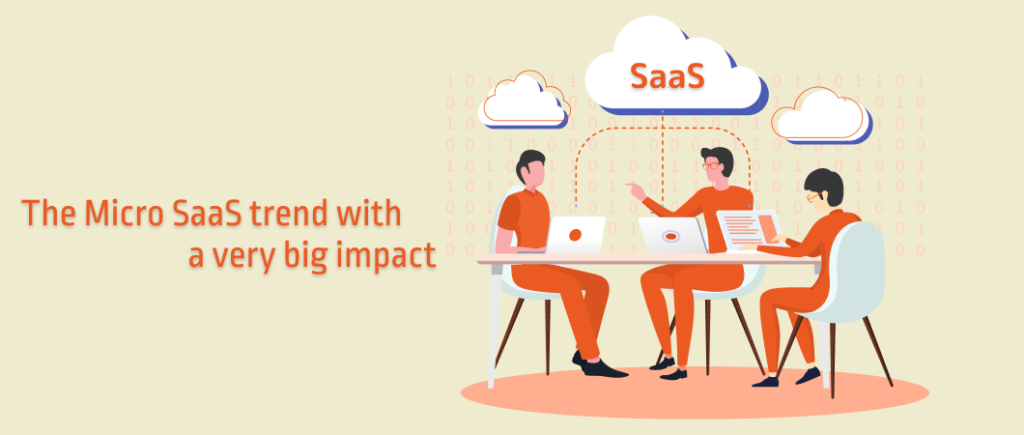Last updated on April 18th, 2024
The tech landscape has witnessed a wave of transformative success stories in the realm of Software as a Service (SaaS). These stories range from toppling established enterprise products to fostering fresh revenue streams through purely digital services. The benefits, from cost reduction to seamless scalability and reliability, have become widely acknowledged. However, the domain of SaaS is not confined to revolutionizing large business models alone. It extends its prowess to address even the smallest challenges or user groups.
At the forefront of this scaled-down revolution within SaaS is Micro SaaS. This term inherently suggests a focus on narrower use cases and a smaller sphere of SaaS technology application. Let’s delve deeper into its workings.
What exactly is Micro SaaS?
Micro SaaS refers to small, specialized software-as-a-service (SaaS) applications that target niche markets or solve specific problems. These applications are typically developed and operated by small teams or even solo entrepreneurs.
Micro SaaS entities typically consist of smaller development teams, often comprising a single individual. Their goal? To create a SaaS offering tailored to support extremely niche use cases within broader ecosystems. Operating with reduced costs, these ventures target more precise revenue streams, commonly self-funding and profitable.
Consider a simple illustration: a SaaS service empowering brands to aid customers in locating the nearest store authorized to sell their products. Without requiring extensive coding expertise, brands embed a small code snippet on their websites to enable this functionality. By capturing a visitor’s geographic information, the SaaS service swiftly maps out the closest stores from the brand’s provided list. This Micro SaaS application, though addressing a tiny use case within the website, significantly enhances the brand’s marketing efforts. While major SaaS solutions like CRM or CSM platforms cater to broader needs like personalized customer experiences, this store locator service offers a highly useful yet compact solution. Opting for Micro-SaaS not only incurs minimal costs for the brand but also signifies success for the service developer, who can host the service on popular cloud platforms.
This example showcases how the Micro SaaS approach delivers pinpoint value, leading to faster returns on investment. The adoption rate is on the rise, accompanied by an increasing number of Micro-SaaS providers. This approach resonates with businesses or entrepreneurs aiming to target niche problems or complement larger SaaS applications with smaller sub-services.
So, why is there a growing trend toward Micro SaaS?
Key Advantages of Micro SaaS
Let’s Explore the four key advantages making micro SaaS an attractive proposition for App and product development in specific niches:
Lower Cost:
Micro SaaS significantly reduces development, management, and maintenance costs, offering a more cost-effective solution compared to larger SaaS applications.
Predictable Revenue Stream:
Micro SaaS models enable businesses to predict revenues based on recurring subscribers for their specific niche service, providing a clear monetization strategy.
Lower Management Overhead:
With its focus on a particular niche challenge, Micro SaaS ventures necessitate minimal complex workflows or business process management, often running efficiently with a small team and limited managerial overheads.
Narrower Business Focus:
Micro SaaS platforms concentrate on a highly specific problem or use case, simplifying operations, design, and user policies. This focused approach garners more customer interest due to its streamlined functionality.
Micro SaaS represents a gateway for small businesses or entrepreneurs to build profitable ventures in the digital economy. Identifying a clear market base is key, followed by building, deploying, and monetizing the service, which, despite its standalone capabilities, best fits as a piece of the puzzle in a larger framework. For software product and application companies, partnering with Micro SaaS solutions offers a win-win scenario, enhancing overall value for end-users.
Forgeahead Solutions specializes in leveraging the Micro-SaaS trend to augment your app or product offerings. Reach out to us and explore how your business can harness Micro SaaS for faster, more comprehensive solutions. Forgeahead Solutions your trusted partner for Micro SaaS Solution.
FAQ
How does Micro SaaS differ from traditional SaaS?
Unlike traditional SaaS, which often targets broader markets and serves larger businesses, Micro SaaS focuses on catering to the needs of smaller, more specialized customer segments. Micro SaaS products are often simpler in scope and functionality compared to their larger counterparts.
What are the challenges of transitioning to Micro SaaS?
Transitioning to Micro SaaS may present challenges such as identifying a profitable niche, competing with larger players, managing limited resources effectively, and ensuring consistent revenue generation.
What are some examples of successful Micro SaaS businesses?
Examples of successful Micro SaaS businesses include tools for specific industries (e.g., project management software for construction companies), niche marketing platforms (e.g., email marketing software for small e-commerce businesses), and specialized productivity tools (e.g., time-tracking software for freelancers).
What are some common pricing models for Micro SaaS products?
Common pricing models for Micro SaaS products include subscription-based pricing (monthly or annual subscriptions), tiered pricing with different feature sets, usage-based pricing, and one-time purchase options with optional add-ons or upgrades.



